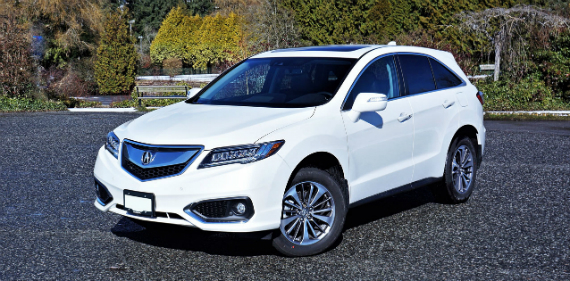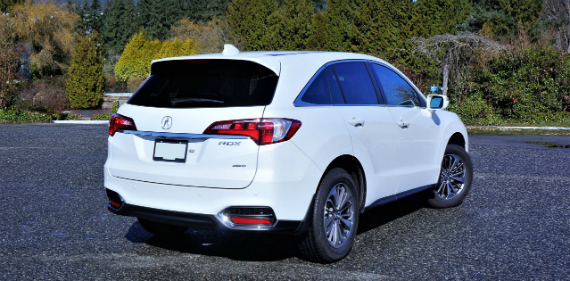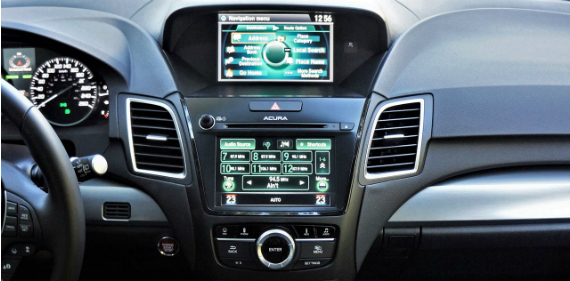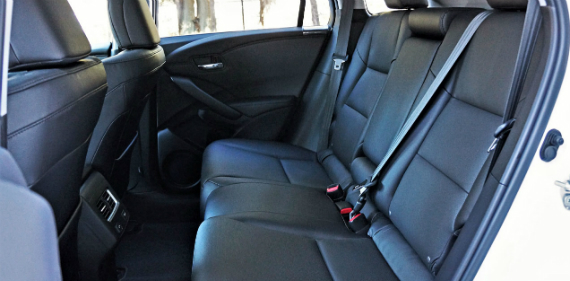2018 Acura RDX AWD

I want you to think about something for a moment. The RDX just passed six years since the current second-generation design went into production in March of 2012, and despite only a minor facelift in 2016, Acura still managed to find more compact luxury SUV buyers in 2017 than all but two of its competitors.
Now consider one of the models that outsold the RDX’ 51,707 units, Audi’s second-place Q5 with 57,640 examples down the road, was all-new for most of last year, so therefore it sold 16.3 percent more units than the year prior due to pent up demand; while the first-place Lexus NX, with 59,341 buyers, arrived as an entirely new model the year before, so is essentially still on its honeymoon. Building on the age issue, the fourth-place Mercedes-Benz GLC, at 48,643 deliveries, was new just two years prior in 2015; the fifth-place Buick Envision, at 41,040 units, is one of the least expensive SUVs in the class and brand spanking new last year; the sixth-place BMW X3, at 40,691 units, entered its third generation partway through the year; and the other nine competitors didn’t sell in high enough numbers to truly compete. So what does the RDX have that the others don’t?
At $36,000 plus freight and fees it’s not the cheapest in the segment, that honor held by the Lincoln MKC that starts at just $33,355, while Infiniti’s QX50 hits the street for $34,650, the aforementioned Buick arrives at $34,990, and Lexus’ NX starts at $35,985, so price is clearly not the sole differentiator. Of note, the only other competitor priced in the $30,000 something range is Land Rover’s Discovery Sport at $37,395.

Obviously premium SUV buyers like the RDX’ styling, its sharp, sporty lines and standard LED headlamps plenty distinctive, while that latter feature brings up another important point, value for money.
The RDX is one of few compact luxury SUVs with standard LED headlights, while the well-proven model comes standard with a powerful V6, a pricey option with its rivals if available at all. One could argue this pro as a con with fuel prices climbing at a fast rate, but rising pump prices haven’t negatively affected SUV sales so far, so this may be an issue for its turbocharged four-cylinder 2019 RDX successor to address.
Yes, if you want a new RDX with a V6 you’d better act quickly. A six-cylinder may show up as an option sometime in the future, but so far such prognostication hasn’t been up for discussion. For all we know the current 3.5-liter V6 with its smooth, linear 279 horsepower and 252 lb-ft of torque, not to mention its well-seasoned six-speed automatic transmission, will be relegated to Acura’s history books when the new third-generation RDX goes on sale later this year. There’s no place for such luxuries in this brave new world where fuel-efficiency comes first and foremost, but this government-forced agenda obviously isn’t an issue with a significant number of compact luxury SUV buyers that keep buying up the RDX in droves.
I’m not of the belief that small turbocharged engines are particularly better at minimizing fuel usage than larger six-cylinder powertrains when saddled with the burden of sizable curb weights, the RDX tipping the scales at 3,926 to 3,962 lbs depending on trim. The relaxed nature of the larger engine can actually save fuel in real world driving, especially when hills and highways are a factor. Even when comparing less-real EPA fuel economy ratings the 2018 RDX fares pretty well at a claimed 19 mpg city, 27 highway and 22 combined with as-tested AWD, next to the similarly popular Mercedes GLC’s 21 city, 28 highway and 24 combined numbers.

The German isn’t the thriftiest or the thirstiest turbo-four in the class, representing a good middle ground that the RDX comes close to matching despite its larger displacement, sportier V6 exhaust note, and more premium feel, this partially due to its still innovative yet long-time use of Variable Cylinder Management (VCM), which automatically shuts down three of its six cylinders when under light loads like coasting. Now, imagine if Acura had chosen to mate this engine up with the more advanced nine-speed automatic found in the MDX, which also benefits from auto start/stop? No doubt it would come even closer to matching the efficiency of its turbocharged four-cylinder peers.
That won’t happen, however, so like I said earlier, make sure to snap up a 2018 RDX if you prefer V6 performance and refinement, the latter aided by Active Control Engine Mounts (ACM), and while you’re at it you should be able to negotiate a significant discount—remember the 2019 RDX is just around the corner.
Even without a special deal the base RDX represents excellent value at $36k, as it comes with the aforementioned V6 and auto on/off Jewel Eye LED headlights, plus standard LED taillights, 18-inch alloys, proximity access, pushbutton ignition, ambient cabin lighting, a leather-wrapped multi-function steering wheel, leather upholstery, heatable front seats, an eight-way driver’s seat with powered lumbar support and a four-way powered front passenger’s seat, two-position driver’s memory for the seat and side mirrors, a HomeLink garage door opener, an auto-dimming centre mirror, dual-zone automatic climate control, a 5.0-inch infotainment display, a rearview camera with dynamic guidelines, Bluetooth phone connectivity with audio streaming, SMS text message functionality, a 360-watt seven-speaker audio system, satellite radio, a powered moonroof, a powered tailgate, and more.

Those who prioritize safety over creature comforts can opt for the Japanese brand’s impressive array of standard AcuraWatch driver-assist systems that for just $1,300 include adaptive cruise control, forward collision warning, autonomous collision mitigation braking, lane departure warning, and lane keeping assist, while this upgrade also includes a more advanced color TFT multi-information display. AcuraWatch allows for IIHS Top Safety Pick status too, while even the base model gets a best possible five stars from the NHTSA. Are you starting to understand why the RDX is so popular?
My tester was upgraded with all-wheel drive, a reasonable $1,500 cost across the entire RDX line, while the mid-range Technology package adds to the RDX’ safety net with blindspot monitoring and rear cross-traffic alert, while also adding a plethora of convenience and luxury items like a larger 8.0-inch LED backlit display with navigation and voice recognition, dynamic guidelines for the backup camera, a separate On-Demand Multi-Use touchscreen display, advanced AcuraLink smartphone connectivity, real-time traffic routing, Siri Eyes Free, a 10-speaker 410-watt ELS Studio audio upgrade, HD radio, Song-By-Voice, Aha compatibility, a more advanced GPS-linked, solar-sensing system for the climate control, perforated leather upholstery, an eight-way powered front passenger’s seat and more for a mere $3,700 added to the bottom line.
Lastly, my Advance package-equipped RDX benefited from sportier looking 18-inch alloys, fog lamps, remote engine start, rain-sensing wipers, auto-dimming side mirrors, front and rear parking sensors, and ventilated front seats, all for only $1,700 extra. Altogether you can get into a fully loaded 2018 RDX for only $44,200 plus freight and fees, less the expected discount noted earlier.

If the RDX were an uncompetitive rolling anachronism undeserving of your time and attention its supposed value proposition wouldn’t be an issue, but it remains a good-looking SUV with a nicely finished interior and strong performance. Starting inside, a generous supply of leather-like padded soft-touch surfaces can be found in all the appropriate places, as can de rigueur fabric-wrapped roof pillars and high-quality, tight fitting, well-damped switchgear throughout. All of the aforementioned features work well, its navigation particularly accurate, while its seats are comfortable and supportive front to back, with rear seat roominess especially good.
Likewise, the RDX can haul more cargo than most competitors thanks to 26.1 cubic feet of capacity behind its rear row and 76.9 cubic feet when its 60/40-split rear seatbacks are folded down, and that’s one of the easiest procedures in the class due to standard cargo wall-mounted levers that drop each side automatically. It’s not the flattest loading floor, with a fairly steep rise in the middle, but it’s something most owners learn to live with.
As for performance, the V6 provides more off the line jump than the majority of base challengers, and while its six-speed automatic might be down a couple of gears by modern-day standards, the torquey engine hardly needs as many shift points to optimize performance. In fact, most won’t notice this shortcoming at all, as it swaps cogs almost unperceivably unless getting hard on the throttle, at which point it does so with nice positive engagements, enhanced by standard steering wheel-mounted paddle shifters for more hands-on command, plus grade logic control that regulates throttle and braking on steep hills. This is joined by standard hill start assist, which locks the brakes so you won’t roll backward before applying the throttle.

Pulling back on those paddle shifters is especially enjoyable when the road starts to wind, allowing more engine control for powering out of corners and then setting up the next turn. The RDX’ well-engineered independent suspension helps most in this respect, mind you, thanks to a MacPherson strut front and multi-link rear setup that’s kept in check via amplitude reactive dampers that minimize fore and aft jounce as well as transitional roll while maintaining a smooth, comfortable ride at all times. Plenty of sound deadening materials along with active sound control aid in refinement too, giving the RDX the kind of upscale experience premium buyers gravitate toward.
So now you know why the RDX still sells so well in spite of its age, and hopefully can appreciate that it remains an impressive luxury SUV despite its attractive price point. No doubt the upcoming 2019 RDX will be a wholly better compact luxury utility, but there’s no reason to put off buying the current version if you need to pull the trigger now. The standard V6 is definitely a performance and refinement bonus with little negative hit to fuel economy, and the model’s marketplace longevity has got to aid long-term reliability expectations. Topping it all off, the RDX’ inexpensive suite of advanced safety features can’t be beat, making it a no-brainer purchase for smart luxury SUV shoppers. All added up, I’ve got to slot the 2018 RDX into my highly recommended category. Too bad there are so few of them left.
*Story credits: Trevor Hofmann, American Auto Press Photo credits: Karen Tuggay, American Auto Press Copyright: American Auto Press *
